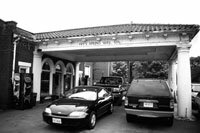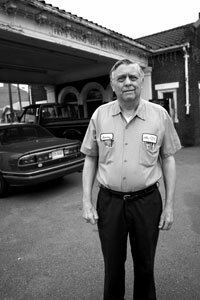NEWS- Nice bathrooms: JPA-area gas station gets historic nod

The Fry's Spring Service Station at Maury and Fontaine will soon be registered as a historic landmark. Check out its Art Deco bathrooms.
PHOTO BY WILL WALKER
All is not Georgian, Federal, or Jeffersonian in the latest crop of candidates for the Virginia Landmarks Register. Well, actually there are Jeffersonian elements in one local landmark, which is described as colonial/Spanish revival.
What's unusual: It's the first gas station to be nominated to the august list.
Fry's Spring Service Station, built in 1931, marks the rise of the car and the decline of Charlottesville's streetcars, which once ferried passengers out to Captain T.O. Troy's public park– public, that is, for whites.
"Automobile culture as it developed is now historic," says Randy Jones at the Virginia Department of Historic Resources. "I pass [old gas stations] all the time on the blue highways and say, 'That should be registered.'"
Fry's Spring Service Station is probably a modification of a design from a book of standardized plans.
"There are other similar stations, like in Belmont," says city preservation and design planner Mary Joy Scala. "What's so great is this one picked up on Jeffersonian details."
"The exterior exhibits a clear Spanish/Colonial revival style with conspicuous references to the local Jeffersonian architectural vocabulary evident in the cornice treatment of the porte cochere and the use of Tuscan columns," says the Department of Historic Resources.
The station's Spanish tile roof is actually made of tin, in deference to the reality of cracking clay in a climate that experiences winter freezes.
Most notable in the design of the filling station is the bathroom breakthrough. The historic landmark application cites the "inclusion of commodious restrooms, which presaged the movement in the late 1930s to improve unsanitary and unattractive washroom facilities."
Hot and cold running water were a big deal, as was the "more lavish" women's toilet and waiting rooms in blue and black tile with a beveled mirror in an Art Deco-ish motif.
For a building situated at the busy corner of Maury and Fontaine avenues, the historic design became a liability for selling gas. "It was hard to get in and out here," says Jimmy Houchens, who runs the garage with his daughter, Kristy.
The historic landmark designation is a form of preservation. "At one time, they were going to tear us down because they were changing the intersection," says Houchens.
His father bought the station in the 1970s from Union Oil Company. Now the garage, which no longer sells gas, does state inspections and automotive repairs. But even its future as a service station looks cloudy, as Houchens, 63, says it's just not profitable. "We depend more on people at the university than the students."
He says he's had interest from potential buyers who would like to turn his service station into an eating station, a la Zinc restaurant on West Main.
A family dispute may also hasten the sale. The property is still listed in the name of Houchens' deceased mother, Ruby, and he says his brother is suing to get his money out of the property. The Hook was unable to reach Larry Steven Houchens.
The landmark application goes before two advisory boards June 6, where it has at least a 90 percent chance of being added to the register, Jones estimates. Once approved, it's on to the National Register of Historic Places, where rubber stamping is the norm.
Fry's Spring Service Station is one of the latest batch of 28 places and things to be added to the Virginia Landmarks Register. Also from Charlottesville is Carr's Hill, the home of the president of the University of Virginia. Built in 1909 by famed architect Stanford White, whose work on the Rotunda was erased in the 1970s, the biggest surprise about the Carr's Hill nomination is that it isn't already registered.
Another local nomination on the list is the Southern Albemarle Rural Historic District. While historic districts are not unusual– there are over 400 in Virginia– only 17 are rural, says Jones. And at 83,000 acres, the southern Albemarle district, which includes historic estates such as Enniscorthy, Plain Dealing, and Morven, is bigger than most. And the nomination notes that in the estate-rich area, a small minority owns a majority of the land.
"What's unusual is the community's level of enthusiasm for it," says Jones, who calls the district "outstanding because of its diversity."
But does it have historic bathrooms?

James Houchens, 63, has been working at Fry's Spring Service Station since 1963, and thinks its days as a garage may be numbered.
PHOTO WILL WALKER
#